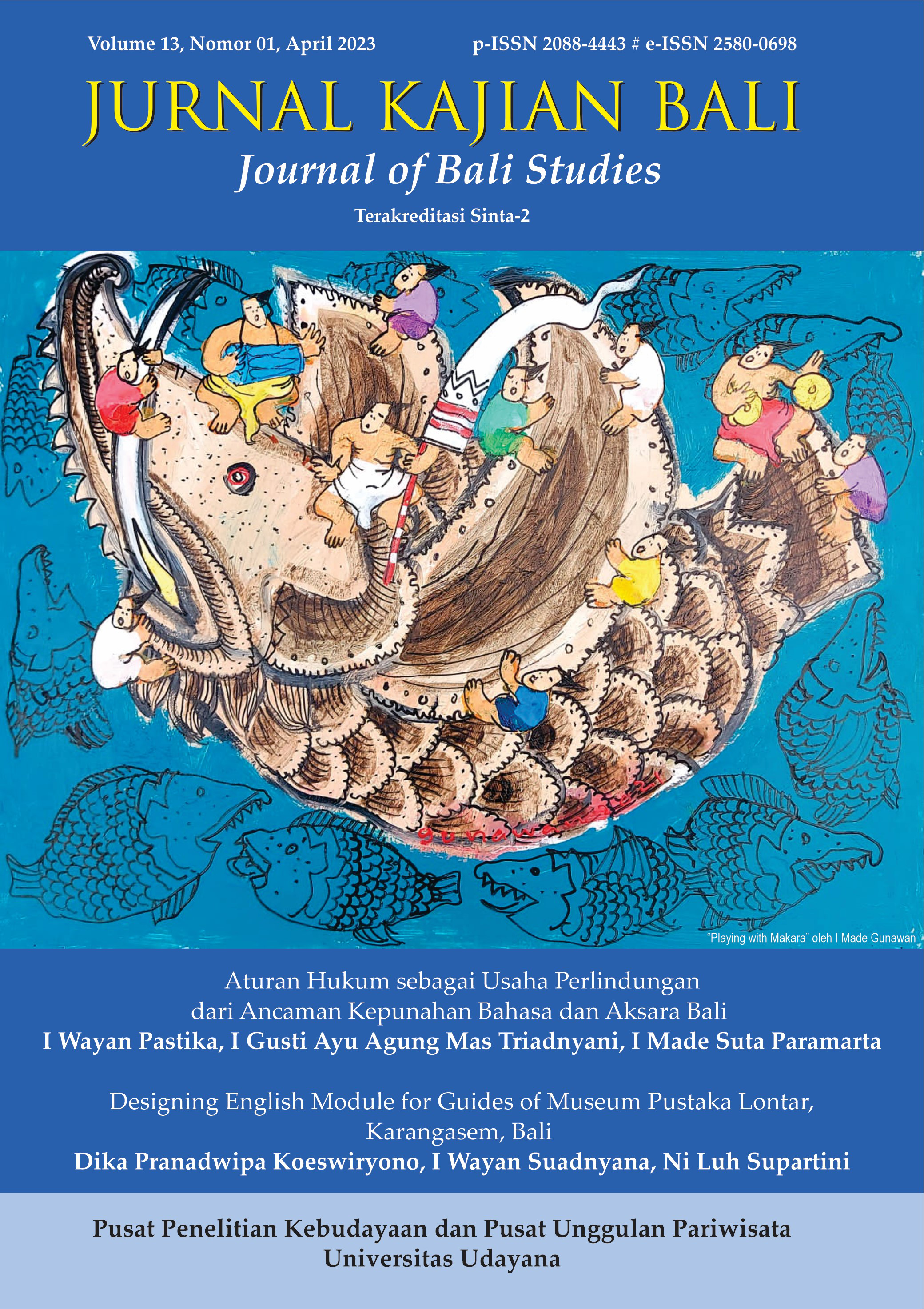Evidence from Balinese: Subject-Versus Object-Control Varies According to the Identity of the Verb, but not Necessarily the Probability of the Event Described
Abstract
The objective of the present study was to investigate whether interpretation (Subject-vs-Object control) of an understudied type of control sentence (Sarahi wants someonej [PROi/j] to entertain) depends at least in part on which scenario is most probable. In Study 1, 44 Balinese speakers each rated the relative acceptability of the Subject- and Object-control readings of 272 Balinese sentences of this type. In Study 2, 20 Balinese speakers rated the likelihood of scenarios corresponding to the Subject- and Object-control readings of the sentences from Study 1. Counter to our predictions, however, these ratings did not significantly predict the relative acceptability of the Subject- and Object-control readings from Study 1, apparently because of other, uncontrolled differences between the verbs. We conclude that the question of whether the interpretation of control sentences depends on the relative probability of the scenarios remains unanswered; similar studies in other languages would help resolve this issue
Downloads
References
Arka, I. W., & Simpson, J. (1998). Control and complex arguments in Balinese. In M. Butt & T. H. King (Eds.), Proceedings of the LFG98 Conference. CSLI Publication. https://web.stanford.edu/group/cslipublications/cslipublications/LFG/3/lfg98arkasimpson.pdf
Artawa, K. (2013). The basic verb constructions in Balinese. NUSA, 54, 5–27.
Artawa, K., Artini, P., & Blake, B. J. (2001). Balinese grammar and discourse. La Trobe Working Papers in Linguistics, 11(2), 11–46.
Barr, D. J., Levy, R., Scheepers, C., & Tily, H. J. (2013). Random effects structure for confirmatory hypothesis testing: Keep it maximal. Journal of Memory and Language, 68(3), 255–278. https://doi.org/10.1016/j.jml.2012.11.001
Bates, D., Alday, P., Kleinschmidt, D., José Bayoán Santiago Calderón, P., Zhan, L., Noack, A., Arslan, A., Bouchet-Valat, M., Kelman, T., Baldassari, A., Ehinger, B., Karrasch, D., Saba, E., Quinn, J., Hatherly, M., Piibeleht, M., Mogensen, P. K., Babayan, S., & Gagnon, Y. L. (2022). JuliaStats/MixedModels.jl: V4.6.2. Zenodo. https://doi.org/10.5281/zenodo.6450229.
Betancort, M., Carreiras, M., & Acuña-Fariña, C. (2006). Processing controlled PROs in Spanish. Cognition, 100(2), 217-282.
Bresnan, J. (1982). Control and Complementation. Linguistic Inquiry, 13(3), 343–434.
Chierchia, G., & Turner, R. (1988). Semantics and Property Theory. Linguistics and Philosophy, 11, 261–302.
Chomsky, N. (1981). Lectures on government and binding. Foris Publications.
Comrie, B. (1985). Tense. Cambridge University Press.
Culicover, P. W., & Jackendoff, R. (2005). Simpler Syntax. Oxford University Press.
Dowty, D. R. (1985). On recent analyses of the semantics of control. Linguistics and Philosophy, 8(3), 291–331. https://doi.org/10.1007/BF00630916
Farkas, D. F. (1988). On obligatory control. Linguistics and Philosophy, 27–58.
Frazier, L., Clifton, C., & Randall, J. (1983). Filling gaps: Decision principles and structure in sentence comprehension. Cognition, 13(2), 187-222.
Geisler, C. (1998). Infinitival Relative Clauses in Spoken Discourse. Language Variation and Change, 10(1), 23–41.
Homeidi, M. A. (2004). Are Exceptional Case Marking Verbs (ECMVs) Truly Exceptional: A Minimalist Approach. Journal of King Saud University, 16(2), 65–74.
Hornstein, N. (1999). Movement and Control. Linguistic Inquiry, 30(1), 69–96. https://doi.org/10.1162/002438999553968
Jackendoff, R. (1969). An Interpretive Theory of Negation. Foundations of Language, 5(2), 218–241.
Jackendoff, R. (1972). Semantic Interpretation in Generative Grammar. MIT Press.
Jackendoff, R. (1974). A Deep Structure Projection Rule. Linguistic Inquiry, 5(4), 481–505.
Jackendoff, R., & Culicover, P. W. (2003). The Semantic Basis of Control in English. Language, 79(3), 517–556. https://doi.org/10.1353/lan.2003.0166.
Kwon, N., & Sturt, P. (2016). Processing control information in a nominal control construction: an eye-tracking study. Journal of Psycholinguistic Research, 45(4), 779-793.
Landau, I. (2000). Elements of Control (Vol. 51). Springer Netherlands. https://doi.org/10.1007/978-94-011-3943-4
Larson, R. K. (1991). Promise and the Theory of Control. Linguistic Inquiry, 22(1), 103–139.
Levinson, S. C. (1987). Pragmatics and the grammar of anaphora: A partial pragmatic reduction of Binding and Control phenomena. Journal of Linguistics, 23(2), 379–434. https://doi.org/10.1017/S0022226700011324
Li, C. (2019). JuliaCall: An R package for seamless integration between R and Julia. Journal of Open Source Software, 4(35), 1284. https://doi.org/10.21105/joss.01284
Manzini, M. R. (1983). On Control and Control Theory. Linguistic Inquiry, 14(3), 421–446.
McDaniel, D., Cairns, H. S., & Hsu, J. R. (1990). Control Principles in the Grammars of Young Children. Language Acquisition, 1(4), 297–335. https://doi.org/10.1207/s15327817la0104_1
Newmeyer, F. J. (2010). Formalism and functionalism in linguistics. WIREs Cognitive Science, 1(3), 301–307. https://doi.org/10.1002/wcs.6
Nishigauchi, T. (1984). Control and the Thematic Domain. Language, 60(2), 215–250. https://doi.org/10.2307/413640
Pollard, C., & Sag, I. A. (1994). Head-Driven Phrase Structure Grammar. University of Chicago Press.
Rosenbaum, P. S. (1967). The Grammar of English Predicate Complement Constructions. MIT Press.
Růžička, R. (1983). Remarks on Control. Linguistic Inquiry, 14(2), 309–324.
Sag, I. A., & Pollard, C. (1991). An Integrated Theory of Complement Control. Language, 67(1), 63–113. https://doi.org/10.2307/415539
Van Valin, R. D., & LaPolla, R. J. (1997). Syntax: Structure, meaning, and function. Cambridge University Press.
Williams, E. (1985). PRO and subject of NP. Natural Language & Linguistic Theory, 3(3), 297–315. https://doi.org/10.1007/BF00154265
Wurmbrand, S. (2001). Infinitives: Restructuring and Clause Structure. Walter de Gruyter.

This work is licensed under a Creative Commons Attribution 4.0 International License.



















